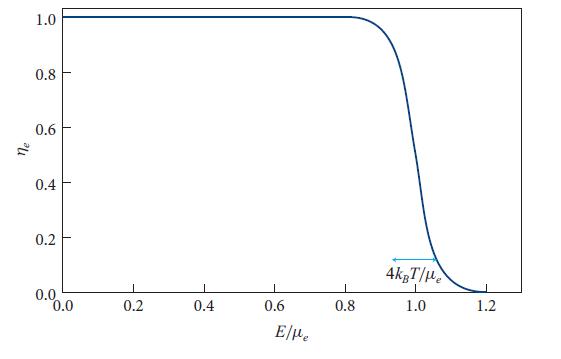Consider a nonrelativistically degenerate electron gas at finite but small temperature.(a) Show that the inequalities k B
Question:
Consider a nonrelativistically degenerate electron gas at finite but small temperature.(a) Show that the inequalities kBT ≪ μe ≪ me are equivalent to the words “nonrelativistically degenerate.”
(b) Show that the electron mean occupation number ηe(E) has the form depicted in Fig. 3.8: It is near unity out to (nonrelativistic) energy E ≈ μe − 2kBT , and itthen drops to nearly zero over a range of energies △E ∼ 4kBT.
Fig 3.8

(c) If the electrons were nonrelativistic but nondegenerate, their thermal energy density would be U = 3/2nkBT, so the total electron energy (excluding rest mass) in a volume V containing N = nV electrons would be Etot = 3/2NkBT, and the electron specific heat, at fixed volume, would be

Using the semiquantitative form of ηe depicted in Fig. 3.8, show that to within a factor of order unity the specific heat of degenerate electrons is smaller than in the nondegenerate case by a factor ∼ kBT/μe:

(d) Compute the multiplicative factor in Eq. (3.60) for CV . More specifically, show that, to first order in kBT/μe,

(e) As an application, consider hydrogen inside a white dwarf with density ρ = 105 g cm−3 and temperature T = 106 K. (These are typical values for a white-dwarf interior). What are the numerical values of μe/me and kBT/μe for the electrons? What is the numerical value of the dimensionless factor (π2/2)(kBT/μe) by which degeneracy reduces the electron specific heat?
(f) As a second application, consider the electrons inside a copper wire in a laboratory on Earth at room temperature. Each copper atom donates about one electron to a “gas” of freely traveling (conducting) electrons and keeps the rest of its electrons bound to itself. (We neglect interaction of this electron gas with the ions, thereby missing important condensed matter complexities, such as conduction bands and what distinguishes conducting materials from insulators.)
What are the numerical values of μe/me and kBT/μe for the conducting electron gas? Verify that these are in the range corresponding to nonrelativisticdegeneracy. What is the value of the factor (π2/2)(kBT/μe) by which degeneracy reduces the electron specific heat? At room temperature, this electron contribution to the specific heat is far smaller than the contribution from thermal vibrations of the copper atoms (i.e., thermal sound waves, i.e., thermal phonons), but at very low temperatures the electron contribution dominates.
Step by Step Answer:

Modern Classical Physics Optics Fluids Plasmas Elasticity Relativity And Statistical Physics
ISBN: 9780691159027
1st Edition
Authors: Kip S. Thorne, Roger D. Blandford





